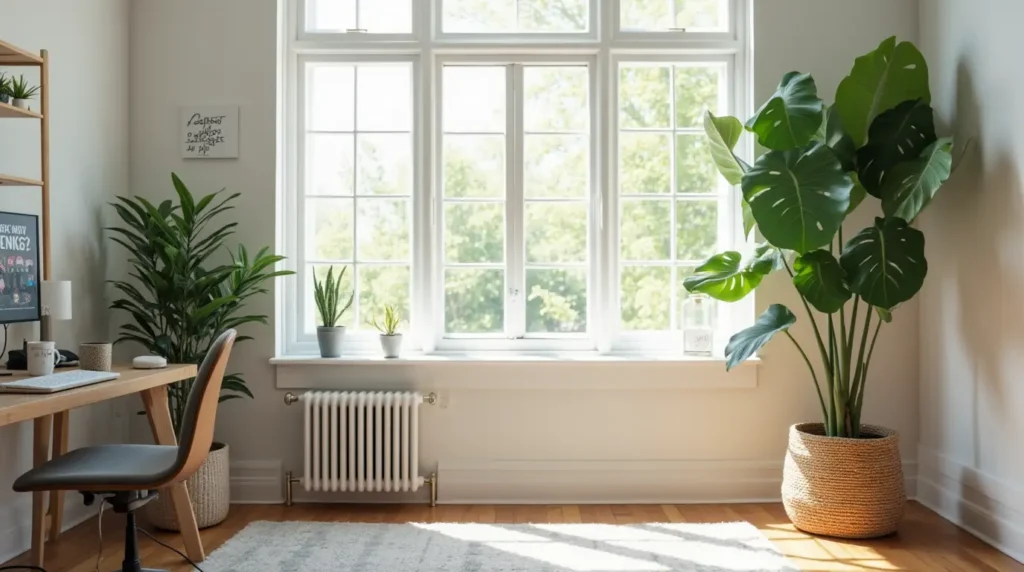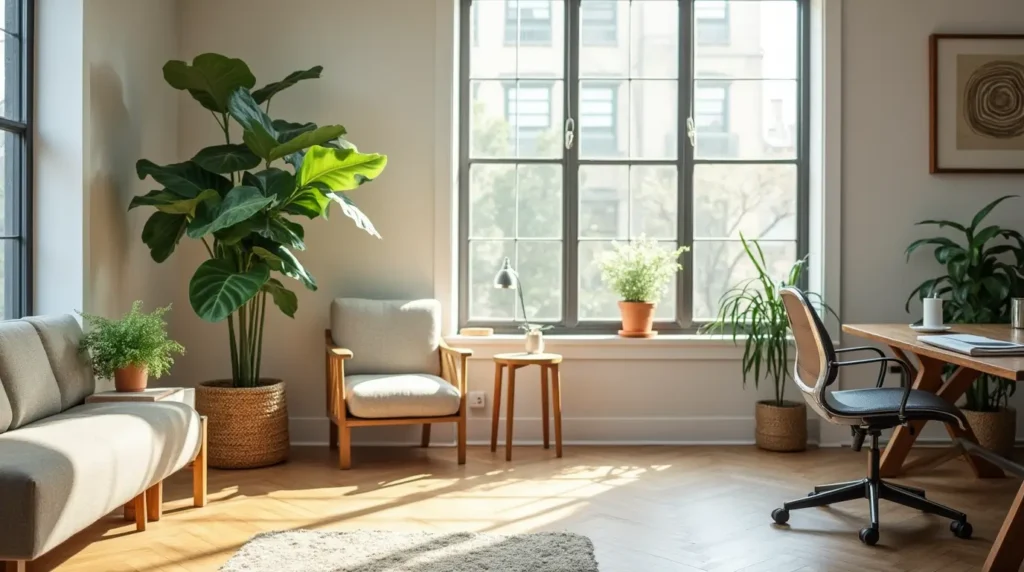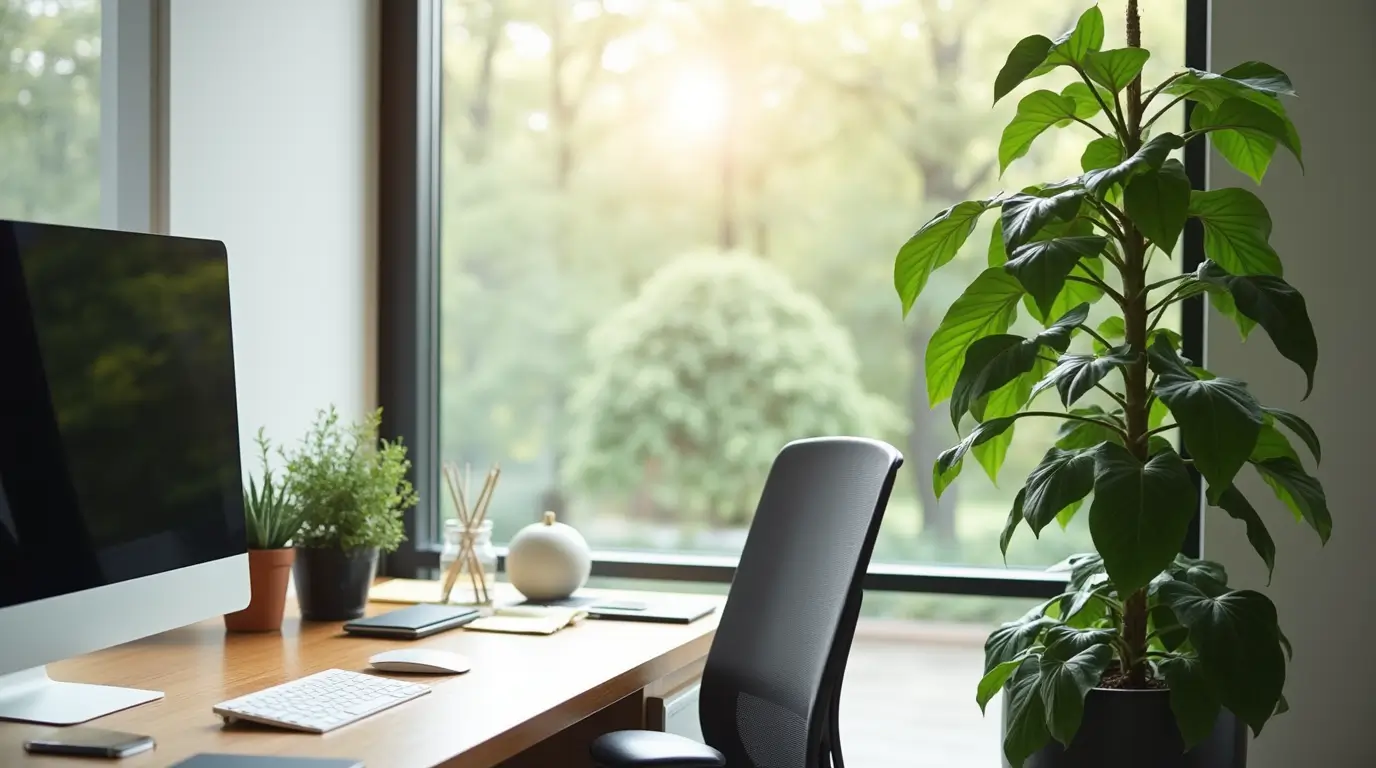Tall Office Plants: Make Your Office Feel Inviting and Productive
Ever felt that your office space could use a little more life and energy? You’re not alone.
Many office workers are beginning to realize the difference a little greenery can make to their productivity, mood, and overall sense of well-being.
We’ve all heard about the benefits of plants at home, but what about at work? If you’re looking to transform your workspace, tall office plants might just be the key you’ve been missing.
Tall office plants do more than just look good; they can elevate the atmosphere of any room. These plants, with their commanding presence and lush foliage, create a sense of sophistication and warmth that smaller plants often can’t match.
They stand tall and proud, filling your space with life, vibrancy, and a burst of nature.
So, why should you consider incorporating tall office plants into your workspace? Let’s dive in and explore the reasons why these plants are a must-have for any office environment.
Why Tall Office Plants Are a Must-Have for Your Workspace

Aesthetic Appeal: More Than Just Greenery
When it comes to office decor, tall office plants stand out. They command attention without being overbearing and bring a touch of natural elegance to even the most neutral, minimalist spaces.
Imagine walking into an office with a towering palm or a sleek fiddle leaf fig—instantly, the room feels more inviting, stylish, and dynamic.
These plants don’t just add greenery in the office; they create focal points that complement and enhance your existing decor.
Whether it’s a corner that needs a little life or an open area that seems to lack personality, tall office plants fit seamlessly into your workspace and make a lasting impression.
Health Benefits: Clean Air and Reduced Stress
Beyond just looks, tall office plants come with health benefits that can improve your day-to-day work experience.
Research has shown that having plants in your office can improve air quality by reducing pollutants, helping to create a healthier workspace.
Additionally, they have a proven track record of reducing stress and improving mood. Whether you’re dealing with tight deadlines or feeling overwhelmed, a tall office plant can provide a calming effect, helping you feel more at ease.
Some studies even suggest that having plants in office spaces can lead to a significant increase in productivity and job satisfaction.
Plants for office spaces don’t just contribute to physical health—they impact mental well-being too.
Boosting Productivity: More Than Just Decoration
It’s easy to see why tall office plants are great for aesthetics, but what about their role in productivity? Believe it or not, adding greenery to the office can improve focus, creativity, and even reduce absenteeism.
According to research, employees who work in environments with plants are more likely to feel energized and engaged. Whether it’s the calming effects of nature or the boost in oxygen levels, plants help people stay on task and maintain a clear, focused mind.
By investing in tall office plants, you’re not just adding decor; you’re creating a work environment that fosters well-being, creativity, and productivity.
So, the next time you feel like your office could use a little more energy, consider the power of plants to transform your space into a hub of motivation and inspiration.
Best Tall Office Plants to Brighten Your Workspace
When it comes to adding tall office plants to your space, you have a range of options, each offering its own unique appeal and benefits.
Whether you’re looking for something that thrives in low light or a plant that adds a dramatic flair, there’s a tall plant to fit every office environment. Here are some of the best options for you:
1. Ficus Lyrata (Fiddle Leaf Fig)
The Ficus Lyrata, commonly known as the fiddle leaf fig, is a popular choice for modern offices. This plant features large, glossy leaves and a striking appearance, making it perfect for adding a dramatic touch to any office decor. It’s an ideal option for larger spaces, where its towering presence can stand out.
- Benefits: The fiddle leaf fig not only adds sophistication to your office, but its bold, architectural shape can also bring an element of style and structure to the room.
- Care Tips: It thrives in bright, indirect light and requires moderate watering—just be sure not to overwater, as it can lead to root rot.
2. Dracaena Fragrans (Corn Plant)
The Dracaena Fragrans, often referred to as the corn plant, is a hardy choice for those who want a tall office plant that requires little maintenance. It’s perfect for spaces that don’t receive a lot of natural light, as it can tolerate lower light levels better than many other plants.
- Benefits: With its lush green foliage and upright growth, the corn plant is perfect for corners or empty spaces. It’s a decorative plant that can easily complement any office decor.
- Care Tips: The corn plant prefers moderate watering and does well in indirect light. It’s low-maintenance and forgiving, making it an excellent choice for beginners.
3. ZZ Plant (Zamioculcas zamiifolia)
If you’re looking for an almost indestructible plant, look no further than the ZZ plant (Zamioculcas zamiifolia).
Known for its tolerance to a wide range of conditions, this plant thrives in environments where others may struggle.
- Benefits: The ZZ plant is nearly indestructible, making it ideal for those with a busy schedule or little plant care experience. Its glossy, dark green leaves bring a unique touch to your office decor, and its low-maintenance nature means you won’t have to worry about frequent watering.
- Care Tips: This plant is adaptable to low light, making it great for offices with minimal natural sunlight. Water it only when the soil is dry to the touch, as it prefers to be on the drier side.
4. Areca Palm
For a tropical vibe that can truly brighten your office, the Areca Palm is an excellent choice. With its graceful fronds and bright green leaves, it brings a sense of lushness and vibrancy to any workspace.
- Benefits: The Areca Palm can act as a natural air purifier, adding both beauty and health benefits to your office. It creates a welcoming atmosphere and pairs well with other decorative plants.
- Care Tips: This palm thrives in bright, indirect light and requires consistent watering, but be sure the soil is well-draining to prevent root rot.
These tall office plants not only improve your office decor but also bring numerous health benefits, such as improved air quality and a reduction in stress levels.
Whether you’re looking for something dramatic like the Fiddle Leaf Fig or a low-maintenance option like the ZZ Plant, there’s a perfect plant for every office setting.
How to Care for Tall Office Plants

Taking care of tall office plants is simpler than it seems, but it does require understanding the specific needs of each plant type.
Whether you’re a beginner or an experienced plant owner, here are essential care tips that will help you maintain healthy, thriving tall office plants in your workspace.
Watering
One of the most important aspects of caring for your tall office plants is finding the right watering balance.
Overwatering and underwatering are two common pitfalls that can damage your plants, so it’s essential to know when and how much to water.
- Overwatering vs. Underwatering: Overwatering can lead to root rot, while underwatering can cause the plant to dry out. Each plant species has its specific needs, but as a general rule, it’s best to let the soil dry out slightly between waterings.
- Ideal Watering Schedule:
- Fiddle Leaf Fig: Water when the top 2 inches of soil feel dry (about once a week).
- Dracaena Fragrans: Allow the soil to dry out between waterings, usually every 1-2 weeks.
- ZZ Plant: Water sparingly—every 2-3 weeks or when the soil feels completely dry.
- Areca Palm: Water consistently, but ensure the soil drains well. Typically once a week during warmer months.
Tip: Use well-draining pots and check for water pooling in the saucer. This ensures you don’t leave the roots sitting in water, which can lead to overwatering.
Light Requirements
Proper light is essential for your tall office plants to grow and thrive. Most tall plants prefer bright, indirect light, but certain plants, like the ZZ Plant, can tolerate low light.
- Ideal Light Conditions:
- Fiddle Leaf Fig: Needs bright, indirect light. Place it near a window that gets plenty of daylight but not direct sun.
- Dracaena Fragrans: Prefers medium to bright indirect light. It can tolerate lower light but will grow slower in dim areas.
- ZZ Plant: Tolerates low light, but for optimal growth, place it near indirect light sources.
- Areca Palm: Enjoys bright, indirect light but can also adapt to lower light conditions.
Maximizing Light in Low-Light Spaces:
- Use Grow Lights: If your office lacks sufficient natural light, consider using full-spectrum grow lights to supplement.
- Proximity to Windows: Even in a low-light office, placing your plant near a window (even if it’s not directly in the sunlight) can help improve its health.
Repotting and Growth
To ensure your tall office plants continue to grow and flourish, regular repotting and maintenance are necessary.
- When to Repot: If you notice roots growing out of the drainage holes, or if your plant appears to have stopped growing, it may be time to repot. Generally, plants should be repotted every 1-2 years, or when their roots become cramped.
- Maintaining Healthy Growth:
- Ensure your plant is in a pot that allows for proper drainage to prevent root rot.
- Feed your plant with a balanced fertilizer during the growing season (spring and summer).
- Keep an eye out for pests and diseases that could affect its growth, and treat them promptly.
Where to Place Tall Office Plants for Maximum Effect
Where you place your tall office plants can significantly impact both the plant’s health and your office’s aesthetics.
The right location ensures your plant has enough light, space, and visibility to thrive while enhancing your office’s atmosphere.
Placement Tips:
- Best Corners for Tall Plants: Tall plants work great in office corners, where they can fill up space without overwhelming the room. They can create a natural focal point and give a more balanced feel to the space.
- Avoid High-Traffic Areas: Place your plants in areas with low foot traffic to avoid accidental damage or bumps. A tall plant can easily become a casualty if it’s in a busy path.
Decorative Benefits:
- Using Tall Plants as Dividers: If your office has an open layout, tall plants can act as natural dividers, creating distinct zones or privacy areas without the need for physical barriers.
- Setting the Tone: Placing tall plants near entryways or workstations adds a welcoming touch. It creates a warm, inviting atmosphere right as someone walks into your office or approaches your desk.
Proximity to Natural Light:
- Importance of Indirect Sunlight: It’s crucial to place your tall office plants near windows that provide indirect sunlight. While direct sunlight can scorch some plants’ leaves, indirect light is perfect for encouraging healthy growth. If your office doesn’t have many windows, don’t worry! Grow lights or strategically positioning plants closer to available light can help compensate.
By following these care and placement tips, your tall office plants will not only thrive but also elevate the ambiance of your workspace, boosting both aesthetics and productivity.
Keeping them healthy and happy is easier than it seems, so long as you pay attention to their needs and provide them with a nurturing environment.
Common Mistakes to Avoid When Caring for Tall Office Plants
Taking care of your tall office plants can be an incredibly rewarding experience, but it’s important to avoid common mistakes that can hinder their growth. Let’s dive into the top mistakes people make and how to prevent them.
Overwatering:
Overwatering is perhaps the most common mistake when it comes to plant care, and it’s easy to do. While you might think you’re helping your plant by giving it more water, this can lead to root rot and other issues.
- Why it’s the most common mistake: Many people water their plants simply because they see dry soil on top, but the roots can still be moist deeper down.
- How to prevent it: Always check the soil moisture before watering. Stick your finger about 2 inches into the soil—if it feels dry, then it’s time to water. Also, ensure your plant pot has good drainage to prevent water from pooling at the bottom.
Ignoring Plant Rotation:
Just like we rotate our bodies for better posture, your tall office plants need rotation for even growth. Plants naturally grow towards the light, so if you don’t rotate them regularly, they may grow lopsided.
- The importance of rotating your plant: Rotating your plant once every week or two ensures even light exposure to all sides, which promotes balanced growth. This is especially important for tall plants that can easily become top-heavy.
Improper Light Conditions:
Placing your tall office plants in the wrong light conditions can stunt their growth or cause them to become unhealthy.
- How to avoid too much or too little light: Tall plants like the Fiddle Leaf Fig thrive in bright, indirect light, while others like the ZZ Plant can do well in low light. Ensure that you’re not placing them directly in the sun or in a completely dark corner. Adjust the position of your plant to match its light requirements.
Ignoring the Plant’s Growth Needs:
As your tall office plants grow, their needs change. Failing to recognize this can cause them to struggle in your office space.
- Adjusting care as the plant grows taller: As plants grow, they may need to be repotted, or their watering schedule may need to be adjusted. Ensure you’re not overlooking these changing needs, and regularly evaluate how your plant is progressing.
Decorative Office Plants and Their Impact on Workplace Culture

Incorporating tall office plants isn’t just about beautifying your space; it’s about transforming your entire office culture. Here’s how plants can positively impact your work environment.
Building a Positive Work Environment:
Plants have been shown to reduce stress and create a more relaxed atmosphere, which can enhance both employee well-being and productivity.
- How plants foster a sense of calm: Studies show that adding greenery to office spaces can lower stress levels and help employees feel more relaxed. Tall plants in particular create a calming focal point and a more serene environment.
- Creating a comfortable atmosphere: Whether it’s a corner plant or a grouping of tall office plants by your workstation, greenery can create a more inviting and pleasant workspace that employees look forward to being in each day.
Plant as a Cultural Symbol:
In many offices, plant care becomes a team-building activity, helping foster a sense of shared responsibility and connection among employees.
- Team-building activity: Watering, repotting, and caring for plants as a group activity can strengthen bonds between employees and improve collaboration.
- Creating a positive workplace culture: When employees share responsibility for office plants, it can help cultivate a sense of ownership and pride in the space. This shared experience can contribute to an overall positive office culture, improving morale and engagement.
How Tall Office Plants Can Help with Focus and Creativity
Plants aren’t just for decoration; they can significantly enhance your cognitive function and creativity. Here’s how.
Connection Between Nature and Creativity:
There’s a deep-rooted connection between nature and human creativity. Studies suggest that having plants in the office environment can boost creativity and problem-solving skills.
- How plants contribute to brain function: Studies have shown that interacting with nature, even through simple exposure to tall office plants, can reduce mental fatigue and increase cognitive abilities. They help improve focus and concentration, which can result in better decision-making and innovation at work.
Real-life Examples:
A 2014 study published in Horticulture Science found that employees who worked in offices with plants were more productive, creative, and happier than those in plant-free environments.
By incorporating greenery into your office, you’re not only enhancing the aesthetics but also helping yourself and your team tap into more creative potential.
Conclusion
Incorporating tall office plants into your workspace offers numerous benefits. Not only do they help transform your office into a vibrant, dynamic environment, but they also contribute to better mental health, improved productivity, and a sense of calm.
So why not start by selecting one or two of the tall office plants mentioned above?
Watch how they breathe new life into your space, giving you and your coworkers the boost you need for a more inviting and productive workday.
FAQ (Frequently Asked Questions)
How do I care for tall office plants?
To care for your tall office plants, focus on three main factors: watering, light, and repotting.
Make sure you’re not overwatering, provide proper light based on your plant’s needs, and repot when necessary to keep your plant thriving.
Can I place a tall office plant near my desk?
Yes, placing a tall office plant near your desk can enhance your workspace’s aesthetics and help you stay focused. Just make sure the plant has enough light and isn’t obstructing your workspace.
Are tall office plants good for low-light spaces?
Some tall office plants, like the ZZ Plant and Dracaena Fragrans, thrive in low-light conditions. For those plants, ensure they’re not exposed to direct sunlight, and they’ll thrive in dimly lit offices.
Do tall office plants need a lot of sunlight?
It depends on the plant species. Some, like the Fiddle Leaf Fig, require bright, indirect light, while others, like the ZZ Plant, can do well with minimal light. Be sure to select a plant that matches the light conditions in your office.
Table: Tall Office Plants Care Guide
| Plant | Watering | Light Requirements | Growth Tips |
|---|---|---|---|
| Fiddle Leaf Fig | Keep soil moist, not soggy | Bright, indirect sunlight | Rotate regularly for even growth |
| Corn Plant | Water when topsoil feels dry | Low to bright indirect light | Can tolerate drought conditions |
| ZZ Plant | Let soil dry between waterings | Low to moderate light | Avoid direct sunlight exposure |
| Areca Palm | Keep soil slightly moist | Bright, indirect sunlight | Needs a good amount of humidity |

